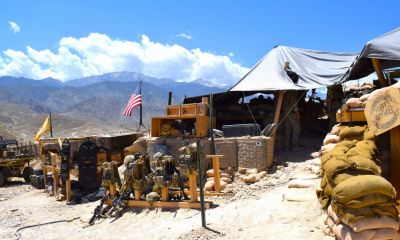- Daniel K. Inouye Asia-Pacific Center for Securi...
- Defeating ISIS in eastern Afghanistan
Defeating ISIS in eastern Afghanistan

Congratulations to Lt. Amy Forsythe, an alumnae of the Asia-Pacific Orientation Course 17-2, who recent had an article published on "Defeating ISIS in Eastern Afghanistan." Forsythe is part of NATO Special Operations Component Command -Afghanistan. Here is a copy of her article:
Defeating ISIS in eastern Afghanistan
Afghan commandos, advised by U.S. Army Special Forces soldiers assigned to NATO Special Operations Component Command-Afghanistan, captured a major Islamic State-Khorasan (ISIS-K) stronghold in eastern Afghanistan in June 2018, effectively depriving the terror group of its local capital in one of the largest joint operations ever conducted between U.S. and Afghan Special Operations Forces.
The joint force of Afghan Special Security Forces (ASSF) and Green Berets killed 170 fighters affiliated with ISIS-K, the terror network’s Afghan offshoot, during a “multi-pronged” assault on the village of Gurgoray that served as the group’s primary base of operations in eastern Nangarhar province. They set up a small base camp in just a matter of a few days, which was approximately 25 kilometers away from the Afghan-Pakistan border.
There were no U.S. or Afghan military force fatalities during the offensive, which involved three Afghan Special Security Forces (ASSF) companies and six U.S. Special Forces teams along with support enablers as part of the mission.
In recent months, ISIS-K took over homes and forced hundreds of families to flee the area, prompting village elders to request assistance from Afghan Commandos. Human intelligence and other reporting indicated ISIS-K were funding themselves through illegal logging and talc mining, as well as exploiting local villagers. ISIS-K, who referred to by locals as ‘Daesh,’ gained a reputation for extreme brutality with executions by beheading and high-profile attacks in Jalalabad and Kabul.
“The achievements by Afghan-led integrated air and ground operations, including the destruction of ISIS-K command and control nodes by Afghan-led ground patrols in Nangarhar, highlight the tremendous growth and increased capability of Afghan Special Security Forces since the Afghan government announced its plans to grow ASSF last year,” said U.S. Army Lt. Col. Joshua Thiel, Special Operations Task Force-Afghanistan commander.
History of ISIS in Afghanistan
A faction of ISIS-K attempted to establish a caliphate in Nangarhar province since its first arrival to Afghanistan in 2014. With an initial design to conquer, then subjugate, the citizens of Jalalabad, ISIS-K continues to attempt to find sanctuary that provides a springboard for its global jihad ideology.
In early 2015, ISIS’s official spokesperson Abu Muhammad al-Abnadi, released an audio statement in which he announced the expansion of the caliphate with the creation of Wilayah Khorasan (Khorasan Province), a historical region incorporating parts of the modern-day Afghanistan and Pakistan.
Tensions between existing Taliban fighters and the ISIS-K faction increased, and fighting between the two groups broke out in Nangarhar province. By June 2015, ISIS-K fighters, comprised of both Afghans and foreign fighters, seized territory in Afghanistan for the first time.
Upon receipt of U.S. presidential authorities to target Islamic State affiliate militias in January 2016, U.S. Forces in Afghanistan (USFOR-A) aggressively pursued ISIS-K in remote and non-populated areas of Nangarhar that they claimed as their caliphate.
Under pressure, ISIS-K relocated and then declared Mohmand Valley in Achin district as their center of operations.
The announcement of the U.S. South Asia Strategy in July 2017 ushered in a conditions-based approach to an enduring U.S. commitment in Afghanistan. This policy enabled the execution of a joint special operations offensive operation, January 2018, which pushed ISIS-K seven kilometers from their previous holding in Mohmand Valley. Suffering their second consecutive and pivotal loss, ISIS-K retreated into nearby Gurgoray village in Deh Bala district to conduct terror operations.
Partners Clearing the Valley Together
The Afghan government offered an unprecedented cease-fire to Taliban forces in mid-June which offered an opening to intensify efforts against ISIS-K.
The Nangarhar operation assembled one of the largest contingents of Afghan Commandos and Green Berets ever to push ISIS-K back into the rugged terrain and return land and homes to their rightful Afghan owners.
“This area, two months ago, was controlled by Daesh,” explained U.S. Army Brig. Gen. John W. Brennan, Jr., Train, Advise and Assist Command-East commander “We pushed them into the mountains, so they cannot harm the people here.”
The Afghan Commandos’ success signaled the accomplishment of yet another combat milestone by conducting a successful prolonged counter-terrorism operation with the use of three Afghan Commando companies from two Special Operations Kandaks, or SOKs. Placement of the battalion-sized contingent of Commandos in Deh Bala was made possible by the investment made by the government to double the size of the Commando forces, as directed by H.E. President Ashraf Ghani’s 2020 Roadmap. Within one year of the announcement, 4,000 additional Commandos joined Special Operations Kandaks throughout the country and operate as a trusted partner force.
Holding the Line Against a Trans-Regional Threat
The fight against the Islamic State and other militant groups, including Al Qaeda, is at the heart of the counter-terrorism mission being conducted alongside Afghan Commandos throughout the country.
“This operation proved that putting troops on the ground, in addition to continuous air strikes, was the right combination to prevent ISIS-K from infiltrating the country from the east,” said Thiel. “The Afghan National Army and Afghan Border Force troops will maintain a presence in the area to ensure ISIS-K won’t re-establish their caliphate along the porous border of eastern Afghanistan. And we will continue to stand firmly with our Afghan partners and support ASSF growth, operations and our enduring partnership for global security.”
The original article can be found online at: https://www.dvidshub.net/news/285315/defeating-isis-eastern-afghanistan

